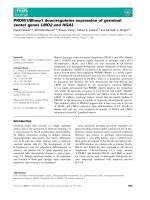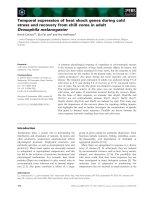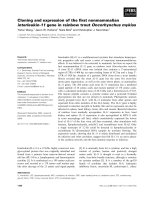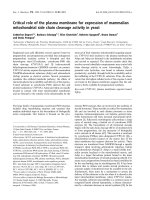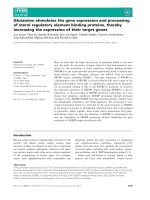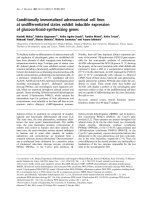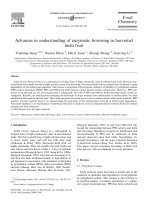Antisense expression of polyphenol oxidase genes inhibits enzymatic browning in potato tubers
Bạn đang xem bản rút gọn của tài liệu. Xem và tải ngay bản đầy đủ của tài liệu tại đây (3.23 MB, 5 trang )
/RESEARCH
Antisense
Expression
of
Polyphenol
Oxidase
Genes
Inhibits
Enzymatic
Browning
in
Potato
Tubers
Christian
W.B.
Bachem",
Gert-Jan
Speckmann1,
Piet
C.G.
van
der
Linde2-5,
Frank
T.M.
verheggen2,
Michelle
D.
Hunt3,
John
C.
Steffens3
and
Marc
Zabeau1*
•Keygene
N.V.,
Agro
Business
Park90,
P.O.
Box
216,
6700
AE
Wageningen,
The
Netherlands.
:RZ
Research
B.V.,
P.O.
Box
2,
9123
ZR
Metslawier,
The
Netherlands.
3Cornell
University,
252
Emerson
Hall,
Ithaca
NY
14853-2703,
USA.
Present
addresses:
"Department
of
Plant
Breeding,
University
of
Wageningen,
P.O.
Box
386,
6700
AJ
Wageningen,
The
Netherlands.
5Stichting
Bedrijfslaboratorium
voor
Weefseikweek,
P.O.
Box
52,
2371
AB
Roelofarendsveen,
The
Netherlands.
*Corresponding
author.
Spoilage
causedby post-harvest enzymatic browning is a problem ofconsiderable importanceto
food
growers, processors and retailers. Here weshow that antisense inhibition of polyphenol oxidase (PPO)
gene
expression
abolishes
discoloration after bruisingofpotato tubersinindividual transgenic
lines
grown
under field conditions. Using appropriate promoters to express antisense PPO RNA, melanin formation
canbe
specifically
inhibited inthe potatotuber.Thislackofbruising
sensitivity
intransgenic potatoes, and
the
absence
ofanyapparent detrimentalside
effects
openthe
possibility
of
preventing
enzymatic browning
in a
wide
variety of
food
crops without resorting to treatments such as heating or the application of
antioxidants.
Received31 May1994; accepted 1
August
1994.
The
development of brown discoloration in a wide
range of fruit and vegetables reduces consumer
acceptability and is thus of significant economic
importance to the primary producer and the food
processing industry1. As well as affecting the har
vestedproduce, brown staining of processed products
such as in juices, pulp, and homogenates currently
necessitates the use of various food additives. Traditionally,
browning in foods has been controlled by the use of sulfiting
agents. Such food additives have been used in a wide range of
fresh, frozen, and processed products, including potatoes, let
tuce, mushrooms, avocados, grapes, many baking products,
wine, beer, and seafood, in which the process of enzymatic
browning is a significant problem. Recently, however, doubt has
been cast on the safety of sulfites for human consumption. The
U. S. Food & Drug Administration, for example, has rescinded
the GRAS (Generally Recognized As Safe) listing for several
sulfiting agents for use on fruit and vegetables and more are
being
reviewed2.
In potato tubers, injury during mechanical harvesting and
subsequent handling causes areas of the tuber to developdiscol
ored patches (blackspot) which extend from the site of impact.
Although potato blackspot is frequently not associated with
visible tissue damage, it can be the cause of severe crop losses
during grading for both tablestock and frozen
products3-4.
The
discoloration of the damaged tissue results from the enzymatic
production of complex polyphenolics5, also referred to as mela-
nins. In bacterial and mammalian systems, melanins are
regarded as the oxidation products of tyrosine derived from
monophenolmono-oxygenase
activity.
In plants, this activityis
often not detectable. Furthermore, the colored oxidation prod
ucts of PPO activity can result from polymerization of a wide
variety of different phenolic compounds. In this paper we use
the term melanin in the broad sense to denote polyphenolic
pigmentsformed by auto-oxidation of PPO-derived quinones.
A large number of interacting genetic and environmental
factors
influence
enzymatic browning in potatoes including
tuber dry matter as wellas availability and levels of
substrate3-6.
The firststepsin the
pathway
leadingto the formation of mela
nins
involve
theoxidation ofmonophenols and o-diphenolstoo-
quinones. Further
oxidative
reactions, thought to be largely
non-enzymatic, then give rise to polyphenolic melanin-like
compounds7-8.
The enzyme thought to be responsible for initial
steps in this pathway is polyphenol oxidase1. Plant PPOs are
nuclear-encodedcopper metalloproteins,with a molecular mass
of circa 59,000 and are localized in membranes of
plastids9.
Plant genesencodingthisenzyme havebeen recently cloned and
characterized10"13.
Although the sequences of plant PPO genes
are very similar, only the putative copper binding sites are
conserved when the plant genes are compared to mammalian,
bacterial, or fungal
tyrosinases12.
While PPO enzyme activity
has been implicated in the browning of plant tissues after dam
age, no biological function has been unequivocally assigned to
PPO in intactplant tissue. Interest in the biological function of
PPO as well as the need to ameliorate the severe losses caused by
PPO-mediated browning in potato and other agricultural com
modities led us to evaluatethe possibility of engineering black-
spot resistance in potatoes using molecular techniques. One of
the most successfulmethodsdevelopedin recent years to inhibit
gene expressionin plantshas been concomitant expression of an
introduced antisense
gene14.
In this paper we describe the isola
tion of tuber-specific PPO cDNAs and the inhibition of PPO
expression in transgenic potato plants by expressing a series of
antisense PPO gene constructs driven by constitutive and tissue
specific promoters.
Results
Isolation and characterization
of
tuber-specific potato
PPO
cDNAs.
Two
PPO
cDNAs
have
been
isolated
from
potato". In order to
analyze
genes that are expressed in the
BIO/TECHNOLOGY
VOL.
12
NOVEMBER
1994
1101
•
•
•
.
r t
f %
^•^F'f'^UM^
ff
"•
1
Sense
&
antisense
PPO
sequences:
Exprmion
MMM
FIGURE
1.Construction of the sense andantisense
PPO
plas-
mids.
All
PPO
gene fragments were
derived
from
the
original
cDNA clones using
PCR
assisted cloning. The approximate
positions of primers for PCRs are Indicated by small
arrows
and the restriction sites incorporated into the
primers
are
shown.
The
large arrows
show
the
direction of translation of
the
PPO
gene.
Right and left
borders
of
the
T-DNA
vector
are
indicatedby RB,and LBrespectively. pNOS,
NPTII
and
NOS
are
abbreviations
for
the nopaline synthase
promoter,
the neomy
cin phosphotransferase
II
gene and the nopaline synthase 3'
transcription terminator region.
TABLE
1. Classification of
cDNA
clones isolated
from
a
potato
tuber
library.
The sizes of the clones were estimated by gel
electrophoresis or by.
sequence
determination in the
case
of
pKG45-8
and
pKG59-4.
5'
terminal
sequencing
(circa
500
bp)
was carriedout on alllisted clones to determine the identity of
the gene givingriseto the
cDNA
clone.When sequence
Iden
tity was foundbetween
individual
clones a putative
PPO
gene
(A-D)
was assigned to the sequence. Classes
(I
or
II)
were
assigned
to a cDNA
clone
when
It revealed
more
than 75%
sequence
Identity to either pKG45-8 (Class
I)
or pKG59-4
(Class
II).
Class
Gene
CDNA
clone
size in bp
I
A
pKG45-5
pKG45-8
1850
1875
II
B
pKG59-4
pKG45-6
pKG45-4
pKG45-7
pKG45-9
pKG59-l
1931
1800
1600
1600
1400
500
II
C
pKG45-ll
pKG45-3
1800
1500
II D
pKG45-10
1300
II
E
pKG59-2
800
tuber, a cDNA library from
developing
tubers15
was
screened
with
leaf
PPO
cDNAs".
Partial
sequence
analysis
was
carried
outon
the
12
largest
clones
isolated.
The
analysis
of
sequence
data
showed
that all
cDNA
clones fell into two distinct classes.
The complete sequences were determined from one clone of
eachclass
(pKG45-8
[Class
I],
pKG59-4
[Class
II]).The
Class
I
clone
from
tuber
(pKG45-8)
is
highly
homologous
to
the
potato
leaf clones (pPPO-PI"; 98.8%
sequence
identity),
while
the
Class II clone
(pKG59-4)
showsmoresimilarity to the
tomato
PPO
clone;
(PPO
F':|};
80.1
%
sequence
identity)
than
to
any
potato
cDNA
clones isolated to date. Class I and Class II share
1102
Rin/TFrHNni
nnv
\/ni
i9MnwPMneniocM
i 4
72.4%
homology.
At
least
five
different
PPO
genes
or
allelic
variants
of
these
genes
are
expressed
in
the
potato
tuber
(Table
1;
A-E).
The
most
abundantly
represented
transcript
in
this
tuber
cDNA
library
belongs
to
the
Class
II
gene
family
(B-E).
In
this
group,
transcripts
from
the
B
gene
occur
at
the
highest
frequency.
Construction
of T-DNA
vectors
carrying
antisense
PPO
cDNAs.
In
order
to
maximize
the
chances
of
achieving
a
high
level
of
antisense
inhibition
of
PPO
gene
expression,
we
designed
a
series
of antisense
constructs
which
contain
either
the
full-length
PPO
gene
ora
5'-8O0
bp
section
of
both
classes
of
PPO
genes.
We
used
the
CaMV
35S
promoter
which
gives
high
expression
levels
throughout
the
plant16,
as
well
as
two
pro
moters
which
direct
expression
more
specifically
to
the
potato
tuber:
the
granule-bound
starch
synthase
G2817
(GBSS)
and
patatintype
I15
promoters. Asa control,a constructwasusedin
whichtheClass I PPO gene was inserted in a senseorientation
under
the
transcriptional
control
of the
CaMV
35S
promoter.
Constructs
were
also
included
that
lacked
a
PPO
gene
and
carried
the
GUS
marker
gene
(pBI121)18.
The
construction
of
plasmids
used
for
transformation
is
represented
in
Figure
l7 5
Transformation and
analysis
of
transgenic
material.
Two
commercial
tetraploid
potato
varieties were
chosen
for
the
transformation
experiments:
Diamant
and
Van
Gogh.
Both
varieties
have
been
selected
for a
reasonably
good
level
of
blackspot
resistance
when
compared
to
other
varieties.
Thus,
the
challenge
was
to
assess
whether
molecular
approaches
could
increase blackspot resistanceover and above what traditional
breedingtechniques have achieved.
Using
potato
tissue
explants
(internodes)
in
co-cultivation
experiments
we
produced
50
independent
transformants
per
construct
andvariety,
yielding
1400
transgenic
lines". In
order
to verify the transformationprotocol and to obtaindataon the
average copy number of transgenes in the transformed lines,
Southern
blot
analysis10
was
carried
out
at
random
ona
sample
of
50
lines,
including
representatives
from
each
construct
type
for
both
varieties.
The
average
copy
number
was
3
and
the
predicted
restriction patterns were
obtained
forall lines
tested,
confirming
transformation
and
the
integrity
of
the
insert
(data
not
shown).
Foran
initial
elimination
screening
of
all
1400
transgenotes,
the
lines
were
cultured
for
microtuber
production,
and
these
tissues
were
then
used
in a
PPO
enzyme
assay.
We
found
no
statistically
significant
differences
between
the
ability
of
differ
ent
antisense
PPO
genes
(Class
I and
H)
to
suppress
PPO
activity,
nor
were
there
significant
differences
with
respect
to
the
size
of the
PPO
gene-sections
used
inthe
constructs.
Thus,
in the analysis of results presented below, these variants are
grouped
together,
and the
means
compared
to
GUS-trans-
formed
controls.
In
the
cultivars
Diamant
and
Van
Gogh,
74%
and
72%
of
antisense
transformants,
respectively,
gave
lower
PPO enzyme activity than the GUS-transformed controls. In
total, thirty-two lines harboring antisense PPO constructshad
no
detectable
PPO
activity.
Notably,
onlyoneof
these
lineswas
transformed
with
the
patatin-promoter
construct.
Conversely,
very
high
enzyme
activity
was
found
in
individual
lines
express
ing
the
PPO
gene
ina
sense
orientation.
PPO
enzyme
activity
in
these
transgenic
plants
reached
levels
up to
7-fold
higher
than
GUS-transformed
controls in
Diamant
andupto
10-fold
inVan
Gogh
lines.
In
Figure
2 the
mean
PPO
enzyme
activities
in
microtubers
are
shown
forthethree
promoters
used
andfor the
two potato varietiesseparately. Each bar represents the mean
value
of 200
transgenic
lines.
Both
potato
varieties
show
reduced mean enzyme activities when either the CaMV 35S or
GBSS
promoters
are
used.
In
contrast,
transgenic
plants
expressing
antisense
PPO
genes
from
the
patatin-promoter
con
structs do not show statistically significant reductions.
•
FIGURE
2.
Mean
units
of
microtuber
PPO activity In
the
transgenic
lines
expressing
antisense
PPO
genes
are
significantly
reduced
when
the
35S
CaMV and
GBSS-G28
promoters
are
used
to drive
the
antisense
PPO
gene,
when
compared
to
both
the
patatin pro
moter
and
the
control.
The
data
repre
sents
the
means
of 50 replicate
lines,
4
different PPO
genes
per
promoter
per
variety. Data
was
statistically
examined
by analysis of variance (ANOVAII) and
subsequently
tested
with
the
Student-f
test.
Standard
errors
of
the
means
are
Indicated.
Diamant
Van
Gogh
i
09
O
E
&
c
S
ClUflU
OUI
fxan
Cvn
Promoters
CUVMS
QBiS
rw
Cam
Promoters
Transcript analysis in transgenic potato lines. To verify
the data obtained from the enzyme assays and to obtain some
understanding of the kinetics of PPO expression in the
transgenic potatoes, we analyzed mRNA isolated from young
leaves,
stolon
tips
initiating
tuberformation, and
young
potato
tubers(Fig. 3A, B,andC, respectively). The transgenicschosen
forthis
experiment
werenine
Van
Goghlines
(three
lines
from
every promoter combination) containing full length antisense
PPO
genes and showing the lowest PPO enzyme activity in
microtubers. Constructs expressing a CaMV 35S driven PPO
gene in sense orientation and a CaMV 35S-GUS transformed
control were also included. When
poly-A4
RNA isolated from
either leaf, stolon or tuber of plants harboring the CaMV 35S
promoter antisense PPO constructs was probed with an internal
doublestrandedDNAfragmentofpKG59-4, virtuallyno signal
could be detected in any of the lines tested (Fig. 3ABC; lanes
3-
5).
However,
PPO-gene transcript was detected in leaves of
plants transformed with antisense constructs driven by both
GBSS-G28 and patatin promoters (Fig. 3A, lanes 6-11). The
weakly reduced transcript levels in leaves of the pGBSS/anti-
sense PPO plants may well reflect the low levelof
GBSS
pro
moter activity in these tissues. Interestingly, in stolon tips
initiating tuber formation, PPO transcript was detected in the
poly-A*
"RNA from all lines containing patatin promoter con
structs (Fig. 3B; lanes 9-11) which disappears during further
tuber development (Fig. 3C; lanes 9-11).
Immunoblot
analysis
of
PPO proteins in tubers
of
transgenic potatoes. Protein wasextracted from microtubers of
the same lines as those used in the transcript analysis, and
immunoblot analysis was carried out using a polyclonal anti
body raised against purified
Solarium
berthauhii
PPO21.
The
results (Fig. 4) show abundant PPO protein in the sense con
struct (lane 2) when compared Jothe GUS-transformed control.
Virtually no PPOprotein could be detected in any lines carrying
the
CaMV
35S
and
GBSS
constructs.
However,
control
levels
of
PPO protein were revealed in the patatin-driven antisense
PPO
lines.
Field evaluation. In conventional potato breeding practice,
standardized
tests
are
carried
out
to
determine
the
extent
of
discoloration after bruising in tubers from breeding
lines2:.
An
index (BI) iscalculated forblackspot sensitivity which takesinto
account the level of tuber discoloration after subjecting them to
standardizedmechanical damage and subsequent storage at low
temperature. The resulting index ranges from 0 to 50. Indices
from tubers of 50 lines were determined after in
vitro
propaga
tionand plantinginfieldtrials in Metslawier,northernHolland,
in
1992
(Fig. 5). Lines were selected on the basis of enzyme
assays
described
above.
A significantly lower
level
of discolor
ation was noted on visual scoring, after tubers had been peeled,
in lines carrying either CaMV 35S—or GBSS promoter driven
1 *
T^
TTTTYT*TT?y*TJ
HFTTT
?M
I II III
12
345
678
9
10
11
A.
Leaf
B.
Stolon
c.
Tuber
FIGURE 3. Northern
analysis
of
transgenic
potato
plants.
Expression of PPO
mRNA
in
leaves
(A),
stolon
tips
initiating
tubers
(B)
and
young
potato
tubers
(C).
The
two
controls
are
poly-A* RNA from a GUS-transformed line (lane 1) and from a
sense
construct
(lane
2).
The
first
block
of
three
lanes
(I;
lanes
3-5)
is poly-A+ RNA from plant
tissues
expressing
PPO
under
control of
the
35S
CaMV
promoter,
the
second
block
(II;
lanes
6-8)
from
the
GBSS
promoter
and
block
III
(lanes
9-11) from
the
patatin promoter.
The
filter
was
probed
with
an 800 bp
internal
fragment
of
the
Class
II PPO
gene
labeled
with
32P.
59
kd
"I P
1 2 3 4 5 6 7
8 9
10
11
FIGURE 4.
Immunoblot
analysis
of PPO protein from
micro
tubers
in
the
same
lines
as
those
used
in
the
northerns.
The
two
controls
are protein from a
GUS-transformed
line (lane 1)
and
from
a
sense
PPO
construct
(lane
2).
The
first
block
of
three
lanes
(I;
lanes
3-5)
Is
protein
from
plant
tissues
express
ing
PPO
from
the
35S
CaMV
promoter,
the
second
block
(II;
lanes
6-8)
from
the
GBSS
promoter
and
block
III
(lanes
9-
11) from
the
patatin promoter.
Ten
micrograms
of total protein
was
loaded
per
lane
and
the
filter
was
probed
with
polyclonal
antibody raised against purified PPO from Solarium berthaultll
as
described11.
BIOTECHNOLOGY
VOL. 12
NOVEMBER
1994
1103
W
•
Diamant
Van Gogh
cams*
aan
Promoters
P^2^
^?*
fcrJJ
lb
- 1
,
I
^Fvaafi^-
^^^
^B
1 diamaxt
control*
1
DIXMXJCT
»ntl«on»o
ppo
1
FIGURE
6. Bruising phenotype of an untransformed control
and a transgenic line ofthe variety
Diamant
showing the med
ullary
browning
In
the control and the pale color
In
the
transgenic.
Both
potato
tubers
had
been
treated
identically
prior to photography.
antisense PPO genes. These results were further substantiatedin
the
discoloration
indices,
where
significantly
lower
indices
were
calculated in these transformants for both varieties when com
pared
to
the
patatin
promoter
constructs,
even
though
the
latter
had
also
been
preselected
on
the
basis
of
low
enzyme
levels.
Figure
6
shows
a
section
through
a
typical
bruised
tuber
from
a
Van
Gogh
transgenic
line
carrying
an
antisense
PPO
gene
under
the
control
of the
GBSS
promoter
with
a
non-transformed
con
trol depicted next to it.
Discussion
Modulating
gene
expression
using
antisense
technology
is
rapidly
becoming
an
important
approach
for
achieving
targeted
alterations
in
plant
biochemical
pathways.
Commercial
applica
tions now include alterationsof
flower
color14,
virus resistance
(reviewed
inref.23)and
fruit
ripening24.
Our
results
extend
the
possible
uses
of
antisense
technology
toan
area
of
food
quality
not previously investigated.
1104
BIO/TECHNOLOGY
VOL. 12
NOVEMBER
1994
FIGURE
5.
Discoloration
Indices
of
(Bl)
the
field
grown transgenic potato lines
show
a
significant
decrease
in
values
when
either
the
35S CaMV or GBSS-G28
promoters
were
used
In
the
constructs.
Although the patatincontaining lines had
been selected
from
the total
group
of
transgenics on the basis of low enzyme
activity, no significant differences could
be
established
from
the
controls in either
variety.
The
two
varieties
used
in
the
transformation
experiments
show
an
initial
difference
in
their
bruising
phenotype
with
the
variety
Diamant
having
a
lower
browning
susceptibility
than
Van
Gogh.
This
was
reflected
in
the
antisense
transgenics,
where
a
significandy
larger
reduction
in
both
enzyme
activity
and
bruising
phenotype
was
achieved
in
the
latter
variety.
The
conclusion
that
can
be
drawn
from
these
tests
is
that
a
high
percentage of blackspot resistant lines can be selected from
transgenic
potatoes
expressing
an
antisense
PPO
gene
under
the
control
of
CaMV
35Sor
GBSS
promoters.
These
results
are in
contrast
with
previous
attempts
to
select
blackspot
resistance
from
tissue
culture-derived
somaclonal
variant
potato
lines,
which
proved
unsuccessful
(F.T.M.
Verheggen;
unpublished
data).
Although
the
reason
forthepoor
antisense
inhibition
of
PPO
expression
in
lines
harboring
the
patatin
promoter
constructs
remains
unclear,
it
seems
likely
that
the
temporal
expression
pattern
conferred
on
the
introduced
antisense
PPO
genes
by
the
patatin
promoter
does not
precisely
coincide
with
the
onset
of
endogenous
PPO
gene
expression
in
the
developing
tuber.
It
was
shown
previously"
that
the
expression
of
potato
PPO
gene
is
developmental^
regulated;
PPO
mRNA
can
only
be
detected
in
early
stages
of
organ
development.
The
presence
of
endogenous
PPO
gene
expression
in
stolons
carrying
the
patatin
antisense
constructs
indicates
that
the
patatin
promoter
may
not
become
fully
active
in
this
tissue
in
time
to
prevent
accumulation
of
PPO
mRNA.
The
early
expression
of
endogenous
PPO
genes
during
organogenesis,
taken
together withthelong
half-life
ofthePPO
protein,
may
well
allow
enough
enzyme
protein
tobe
accumu
lated
during
tuber
formation
to
give
the
high
average
activities
in
the
patatin
antisenseiines
described
above.
In
young
tubers
(1-2
cm
diameter),
some
transcript
is
detected
in
one
of
the
patatin
lines
(Fig.
3C;
lane
11).
This
is
in
agreement
with
the
enzyme
assays
in
which
this
line
also
showed
higher
PPO
activities
in
microtubers.
As
expected,
the
sense
PPO
construct
showed
very
high
levels
of PPO transcript in all
tissues
examined.
These
conclusions
are
also
in
agreement
with
studies
of
patatin
and
GBSS
promoter
activities1517.
Physical
damage
may
be
an
addi
tional
factor
reducing
patatin
promoter
activity".
Of
the
large
population
of
transgenic
PPO
lines
generated,
a
small proportion of lines were not amenable to microtuber
induction
(<1%)
and some of the lines chosen for
field
trials
failed to grow. No correlation,
however,
could be established
between
the
lack
of
viability,
presumably
due
to
somaclonal
variation
inherent
to the
transformation
procedure,
and
decreased
expression
of
PPO.
Continuing
field
experiments
in
which
more
characters
will
be
scored
with
regard
to
disease
and
pest
resistance
and
biochemical
characteristics
may
provide
a
better insight into the normal function of PPO activities in the
biochemistry
of
intact
tissues.
Clearly,
from
an
applied
point
of
view
the
lack
of
aberrant
phenotypes
associated
with
reduced
PPO
expression
suggests
that
the
approach
described
here
may
be
broadly
applicable
to
the
reduction
of
enzymatic
browning
in
a
range
of
commercially
important
plants
and
their
processed
products.
Experimental
Protocol
Plant
materials.
Potato
plants
(Solarium
tuberosum
cv.
Van
Goch
and
Diamant)
were
grown
in
vitro
on
MS
medium:6
supplemented
with
30
g/1
sucrose.
Potato
internodc
explants
were
transformed
with
Agrobacterium
tumefactens
(strain
GV3101)-7
containing
the
antisense-PPO
Ti-plasmid
constructs
using
the
co-cultivation
method
essentially
according
to
proto
cols
described1".
Plant
material
for
molecular
analysis
was
taken
from
plants
grown
in
17
cm
pots
under
green
house
conditions.
Poly-A*
RNA
for
Northern
analysis
was
isolated
from
the
first
two
internodc
leaves
from
stolons
initiating
tuberization
with
3-5
mm
swollen
tips
and
from
tubers
of
1-2
cm
diameter
harvested
at
the
onset
of
flowering
Molecular
biology.
Routine
DNA
manipulations
were
as
described
by
™Aiat'™A
•
Southern'
Northern
and
Western
analyses
of
potato
DNA,
PPO
transcripts
and
proteins,
respectively,
was
carried
out
as
described
previously".
Substrates
for
sequencing
were
produced
using
the
in
vivo
excision
protocol
on
lambda
ZAPII
clones
(Stratagene,
La
Jol
a,
CA)
isolated
from
a
sink
tuber
cDNA
library
kindly
supplied
by
L
Willmitzer.
Poly-A*
RNA
was
extracted
using
poly-d[T],«
oligonu
cleotides
coupled
to
paramagnetic
beads
(Dynal
A.S.
Oslo,
Norwav)
Five
hundred
ng
poly-A*
RNA
was
loaded
per
lane
and
clectophoretically
separated
RNA
was
capillary
blotted
onto
Hybond
N*
membrane
(Amersham,
UK)
and
probed
with
an
internal
DNA
fragment
of
the
PPO
cDNA
pKG59-4
labeled
with
32P.
Protein
was
extracted
from
about
6g
of
microtuber
tissue
of
the
transgenic
lines
used.
10
pg
of
protein
was
loaded
per
lane.
Tandem
Coomassie
blue-stained
gels
were
run
to
verify
eaual
loading. ' ^
Plasmid
constructions.
To
achieve
tuber
specific
expression
the
Class
I
patatin''
and
GBSS-G28
(ref.
17)
promoters
were
chosen.
Fragments
containing
all
sequences
necessary
to
direct
tissue
specificity
were
iso
lated
using
PCR
with
standard
protocols.
Included
in
the
PCR
primers
were
restriction
sitesto
facilitate
cloning
intothe
Ti-vectors.
The
GBSS
promoter
used
was
isolated
from
genomic
DNA
of
the
potato
variety
Bintje
(from
sequence
data
of
the
genomic
clone
G28)17
and
contained
DNA
from
-1184
to
-8. A
Hindlll
site
(5')
and
a
BamHI
site
(3')
were
inserted
at
the
termini
by
inclusion
of the
recognition
sites
in
the
PCR
primers.
This
fragment
was
inserted
into
the
gel
purified
Ti-vector
(pKGlOOl;
described
below)
after
treatment
of
both
fragment
and
vector
with
Hindin
and
BamHI.
The
Class
I
patatin
promoter
used,
contained
DNA
from
base
-1514
to
base
-31
w
(cloned
in
a
pUC8
plasmid
kindly
provided
by L. Willmitzer). Restriction sites Hindlll and
BamHI
were
incorporated
into
the
5'
and
3'
ends
using
PCR
to
allow
cloning
into
Ti-
vector,
pKGlOOl,
after treatmentwith Hindlll and
BamHI.
The CaMV
35S
expression
vector
was
constructed
from
the
vector
pBI121
(ref.
18).
The
modifications
include
replacement
of
the
mutant
NFTII
gene
in
pBI121
and
the
deletion
of
the
GUS
coding
region;
the
resulting
vector
(pKGlOOl)
was
also
the
basis
for
the
other
expression
vectors
described
below.
The
two
tuber-specific
promoters
were
inserted
into
pKGlOOl
resulting
in
pKG
1001/pat:
containing
the
Class
I
patatin
promoter
and
pKG
1001
/GBSS
containing
the
GBSS
promoter.
Antisense
constructs
were
made,
using
each
of the
full-length
PPO
genes.
Another
set of
constructs were made using an 800 bp region around the translation
initiation
site.Asa
general
strategy
for
cloning
PPO
genes
into
Ti-vectors,
sequence
specific
PCR
primers
were
designed
against
the
required
sites
of
the
PPO
cDNAs.
Incorporated
into
these
primers
were
recognition
sites
for
restriction
enzymes
to
be
used
in
the
cloning
(BamHI
and
Bglll,
5'
and
3'
termini,
respectively).
Tuber
PPO
sections
from
pKG59^
and
pKG45-
8
were
inserted
into
all
three
expression
vectors
described
(pKGlOOl
pKGlOOl/pat
and
pKGlOOI/GBSS).
In
these
experiments
both
the
5''
segmentand the full lengthsectionsfromthetwocDNAswereused.All
of
the
14
potato
PPO
constructs
were
introduced
into
Agrobacterium
tumefaciens
strain
GV3101
via
electroporation
and
their
integrity
was
rechecked
by
restriction
enzyme
analysis.
Enzyme
assays.
Five
g
fresh
weight
of
microtubers
from
each line
was
homogenized
in 5
ml
buffer
(10
mM
Na
acetate,
pH
6.0).
PPO
enzyme
assays
were
then
performed
on
this
extract.
Fifty
mM
catechol
was
used
as
substrate
for
the
assay
in
a
total
volume
of1
ml.
Enzyme
activity
is
expressed
astherateof
change
ofODat520
nm/ml
extract/min
at25
CC.
Two
independent
measurements
were
performed
on
each
line
and
the
means
were
used
in
the
further
analysis.
Boiled
extracts
were
tested
and
were
shown
to
have
no
residual
enzyme
activity.
Browningassayand computationofdiscoloration
indices.
Potatoes
harvested
from
each
line,
grown
in
separate
plots,
were
subjected
to
bruising
under
standard
conditions:
2-3
kg
of
potatoes
are
placed
in
a
shaking
device
comprised
ofa
wooden
box
with
padded
walls.
The
box
is
mechanically
agitated
for
30
seconds.
After
the
bruising
procedure,
tubers
are
stored
for4
days
at
8-10°C.
Subsequently
the
potatoes
are
mechani
cally
peeled
until
80%
of
the
skin
is
removed
and
the
degree
of
browning
is
scored
in
terms
of
percent
of
the
surface
area
affected
by
discoloration.
I
* V
The
percentages
arc
categorized
into
four
classes
and
the
number
of
tubers
in
each
class
arc
entered
into
the
following
formula
from
which
the
index
is
determined:
L + 2 x M + 3 X Z
BI
= • x
100
6 x (G + M + L + Z)
Where
G, L. M
and
Z
are
the
number
of
tubers
catecoriscd
in
a
given
dass
ofsurfacc
browning
(G;
0-0.2%,
L;
0.2-0.5%,
M;
0.5-2.0%
and
Acknowledgments
We
thank
M
Holwerda
H.T.
Krijgsheld.
S.H.
van
der
Molen.
MAF
Homes
and
D.
Pouwels
for
their
technical
help;
M.T.J
de
Both
and
L.
Slootmaker
for
help
and
encouragement
throughout
the
project-
G
Simons.
B.
Horvath
and
T.
Bisseling
for
critically
reading
the
manuscript"
j
Wf.1
was
financed
ty
Cebcco
Handelsraad,
RZ
Research.
De
ZPC
and
the
Ministry
of
Economic
Affairs
of
the
Netherlands.
JCS
acknowl
edges
support
from
USDA-NRICGP.
MDH
is
supported
by
a
fellowship
from
the
NSF/DOE/USDA
Plant
Science
Centre
References
1.
Mayer.
A.
M.
and
Hard.
E.
1991.
Phcnoloxidases
and
their
significance
in
fruit
and
vegetables
p.
373-398.
In:
Food
Enzymology.
Fox.
P.
F.
(Ed
)
Elsevier
Science Publishers. New York.
2. The
Federal
Register,
(year?)
51:25021-25026.
3-
2*
^Ccand
HuehcS-
H-
C
1978'
Tuber
quality,
p.
504-539.
In:
The
Potato
Crop:
The
Scientific
Basis
for
Improvement.
Harris.
P.
M.
(Ed.).
Chapman
and
Hall.
London.
4.
Vertregt.
N.
1968.
Relation
between
blackspot
and
the
composition
of
the
tuber
Eur. Potato J. 11:34-44.
5.
Burton.
W
G.
1969.
Black
spot,
physiological
aspects.
Proc.
of
the
4th
Triennial
Conf.of the
EAPR.
(Brest),
p.79-92.
6.
Stark,
J.C,
Corsini.
D.
L.,
Hurley.
P.
J.
and
Dwelle,
R.
B.
1985.
Biochemical
characteristics
of
potato
clones
differing
in
blackspot
susceptibility
Am.
Pot
J
62:657-666.
7.
Katz,
E
Thompson.
C.
J.
and
Hopwood.
D.
A.
1983.
Cloning
and
expression
of
the
tyrosinase
gene
from
Streptomyces
antibioiicus
in
Strcptomvces
lividans
J. Gen. Microbiol. 129:2703-2714.
8.
Vanneste,
W.
H.
and
Zubriihler.
A.
1974.
Copper
containing
oxygenases,
p.
371
In:
Molecular
Mechanisms
of
Oxygen
Activation.
Hayiashi
(Ed.).
Academic
9.
Vaughn.
K.
C.
and
Duke,
S.
O.
1984.
Function
of
polyphenol
oxidase
in
higher
plants. Physiol. Plant. 60:106-112.
10.
Cary.
J W
Lax.
A.
R.
and
Flurkey.
W.
H.
1992.
Cloning
and
characterisation
oi
cDNAs
for
Viaafaba
polyphenol
oxidase.
Plant
Mol.
Biol.
20:245-253.
11.
Hunt.
M.
D.,
Eannctta.
N.
T,
Yu.
H.,
Newman.
S.
M.
and
Stcffcns,
J.
C.
1993
cDNA
cloning
and
expression
of
potato
polyphenol
oxidase.
Plant
Mol.
Biol.
2>\
lJ7~-
Oo.
12.
Newman.
S.
M
Eannctta,
N.
T.
Yu.
H
Prince,
J.
P
Carmen
de
Vince
M
Tanksley.
S.
D.
and
Steffens.
J.
C.
1993.
Organisation
of
the
tomato
polyphenol
oxidase gene
family.
PlantMol. Biol. 21:1035-1051.
13.
Shahar.
T.
Hcnning.
N
Gutfinger.
T.
Hareven.
D.
and
Lifschitz.
E.
1992.
The
tomato
66.3
kD
polyphcnoloxidasc
gene:
molecular
identification
and
develop
mental expression. Plant Cell 4:135-147.
14.
Mol.
J.
N.
M
van
der
Krol.
A.
R.,
van
Tunen,
A.J.,
van
Blokland.
R
de
Lange.
R.
and
Stuitjc,
A.
R.
1990.
Regulation
of
plant
gene
expression
bv
antisense RNA. FEBS 268:427-430.
15.
Rocha-Sosa.
M
Sonncwald.
U
Frommcr.
W
Stratmann.
M
Schell
J
and
Willmitzer.
L.
1989.
Both
developmental
and
metabolic
signals
activate
the
promoterof a class1
patatin
gene.EMBOJ. 8:23-29.
16.
Benfey.
P.N.
and
Chua.
N.
1990.
The
cauliflower
mosaic
virus
35S
promoter:
combinatoral
regulation
of
transcription
in
plants.
Science
250:959-966
17.
Rohde.
W.,
Becker,
D
Kull.
B.
and
Salamini.
F.
1990.
Structural
and
func
tional
analysis
of
two
waxy
gene
promoters
from
potato.
J.
Genet,
and
Breed.
44:311-315.
18.
Jefferson.
R.
A
Kavanagh.
T.
A.
and
Bcvan
M.
W.
1987.
GUS-fusions:
0-
glucuronidasc
asa
sensitive
and
versatile
gene
fusion
marker
in
higher
plants
EMBO
J.
6:3901-3907.
19.
Ooms.
G.,
Burrel.
M.M
Bevan,
M.
and
Hille.
J.
1989.
Genetic
transformation
in
two
potato
cultivars
with
T-DNA
from
disarmed
Agrobacterium.
Theor.
Appl
Genet
73:744-750.
20.
Maniatis.
T.
Fritsch.
E.
F.
and
Sambrook,
J.
1982.
Molecular
Cloning:
A
Laboratory
Manual.
Cold
Spring
Harbor
Laboratory.
Cold
Spring
Harbor
NY
21.
Kowalski,
S.
P
Eannetta,
N.
T,
Hirzel.
A. T
and
Steffens.
J. C.
1992.
Purification
and
characterisation
of
polyphenol
oxidase
from
glandular
tricho-
mesi
of
Solanum
berthaultii.
Plant
Physiol.
100:677-684.
22.
Meijers,
C.
P.
1986.
Handleiding
kwaliteitsbeoordeling
veldgewasaardappelcn
(CKA-I).
IBVL.
Wageningen.
The
Netherlands.
23.
Wilson,
M.
T.
1993.
Strategies
to
protect
crop
plants
against
viruses:
Pathogen
derived
resistance
blossoms.
Proc.
Natl.
Acad.
Sci.
USA
99:3B4-3141
24.
Bird.
C.
R.
and
Ray.
J.
A.
1991.
Manipulation
of
plant
gene
expression
by
antisense
RNA.
p.
207-227.
In:
Biotcchnologv
and
Genetic
Engineering
Reviews.
Vol.
9.
Tombs.
M.
P.
(Ed.).
Intercept
Ltd.
Southampton.
UK.
25.
Belknap,
W.
R
Rickey.
T
M.
and
Rockhold
D.
R.
1990.
Blackspot
bruise
dependent
changes
in
enzyme
activity
and
gene
expression
in
Lemhi
Russet.
Am.
Pot. J.
67:253-265.
26.
Murashige.
T
and
Skoog.
F.
1962.
A
revised
medium
for
rapid
growth
and
bioassays
with
tobacco
tissue
cultures.
Physiol.
Plant
15:473-497.
27.
van
Larebeke.
N
Engler.
G
Holsters.
M.,
van
den
Elsackcr.
S
Zaenen.
J
Schilperoort.
R.
A.
and
Schell.
J.
1974.
Large
plasmid
in
Agrobacterium
tumefa
ciens
essential
for
crown
gall-inducing
ability.
Nature
252:169-170.
BIOTECHNOLOGY
VOL.
12
NOVEMBER
1994
1105
" i ' T
TTlT^TT^rv
!;
» T
